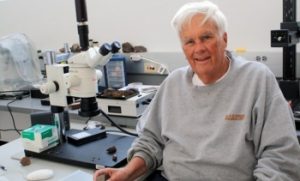Celebrating ASU history: Carleton Moore, meteorites and moon rocks
Looking back at history-making chemistry that's out of this world
It was 60 years ago, in 1961, and the space race was on. Soviet cosmonaut Yuri Gagarin became the first man in space, followed weeks later by American astronaut Alan Shepard. President John F. Kennedy challenged the nation to land a man on the moon by the end of the decade.
Arizona State University’s opportunity to become part of the nation’s space program began when it purchased the largest personal meteorite collection at the time from Harvey Nininger. Nininger’s meteorite collection, consisting of samples from nearly 600 localities, was housed and studied at ASU’s newly formed Center for Meteorite Studies, one of the university’s first research institutes.
To direct the center, ASU courted a recent PhD graduate from the California Institute of Technology, Carleton Moore. Moore, at the time, was teaching at Wesleyan University in Connecticut. On behalf of ASU, Herbert G. Fales flew to Connecticut to recruit Moore.

The Center for Meteorite Studies was originally located in the Department of Chemistry (today the School of Molecular Sciences). One of Moore’s first tasks as director was to organize a symposium on meteorite research to celebrate the inauguration of ASU’s new president, G. Homer Durham.
“Durham was a wonderful guy,” Moore said. “He saw that ASU had to grow, so he was very supportive of our research.”
Research at the Center for Meteorite Studies grew throughout the 1960s, as did Moore’s skill and reputation. Prior to the first moon landing in 1969, Moore was accepted by NASA to chemically analyze lunar samples brought back to Earth by the astronauts. A little over 50 years ago, on the evening of Oct. 7, 1969, history was made at ASU in the C-wing of the physical sciences building when Moore, together with colleague Charles Lewis and graduate student Robert Kelly, obtained the first measurements of carbon in a lunar sample.
Click here to continue reading at ASU News!